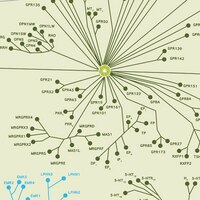MC1R and the response of melanocytes to ultraviolet radiation.
Rouzaud, Francois, et al.
Mutat. Res., 571: 133-52 (2005)
2004
Zobrazit abstrakt
The constitutive color of our skin plays a dramatic role in our photoprotection from solar ultraviolet radiation (UVR) that reaches the Earth and in minimizing DNA damage that gives rise to skin cancer. More than 120 genes have been identified and shown to regulate pigmentation, one of the key genes being melanocortin 1 receptor (MC1R) that encodes the melanocortin 1 receptor (MC1R), a seven-transmembrane G protein-coupled receptor expressed on the surface of melanocytes. Modulation of MC1R function regulates melanin synthesis by melanocytes qualitatively and quantitatively. The MC1R is regulated by the physiological agonists alpha-melanocyte-stimulating hormone (alphaMSH) and adrenocorticotropic hormone (ACTH), and antagonist agouti signaling protein (ASP). Activation of the MC1R by binding of an agonist stimulates the synthesis of eumelanin primarily via activation of adenylate cyclase. The significance of cutaneous pigmentation lies in the photoprotective effect of melanin, particularly eumelanin, against sun-induced carcinogenesis. Epidermal melanocytes and keratinocytes respond to UVR by increasing their expression of alphaMSH and ACTH, which up-regulate the expression of MC1R, and consequently enhance the response of melanocytes to melanocortins. Constitutive skin pigmentation dramatically affects the incidence of skin cancer. The pigmentary phenotype characterized by red hair, fair complexion, inability to tan and tendency to freckle is an independent risk factor for all skin cancers, including melanoma. The MC1R gene is highly polymorphic in human populations, and allelic variation at this locus accounts, to a large extent, for the variation in pigmentary phenotypes and skin phototypes (SPT) in humans. Several allelic variants of the MC1R gene are associated with the red hair and fair skin (RHC) phenotype, and carrying one of these variants is thought to diminish the ability of the epidermis to respond to DNA damage elicited by UVR. The MC1R gene is considered a melanoma susceptibility gene, and its significance in determining the risk for skin cancer is of tremendous interest. | 15748644
 |
Variants of the melanocyte-stimulating hormone receptor gene are associated with red hair and fair skin in humans.
Valverde, P, et al.
Nat. Genet., 11: 328-30 (1995)
1994
Zobrazit abstrakt
Melanin pigmentation protects the skin from the damaging effects of ultraviolet radiation (UVR). There are two types of melanin, the red phaeomelanin and the black eumelanin, both of which are present in human skin. Eumelanin is photoprotective whereas phaeomelanin, because of its potential to generate free radicals in response to UVR, may contribute to UV-induced skin damage. Individuals with red hair have a predominance of phaeomelain in hair and skin and/or a reduced ability to produce eumelanin, which may explain why they fail to tan and are at risk from UVR. In mammals the relative proportions of phaeomelanin and eumelanin are regulated by melanocyte stimulating hormone (MSH), which acts via its receptor (MC1R), on melanocytes, to increase the synthesis of eumelanin and the product of the agouti locus which antagonises this action. In mice, mutations at either the MC1R gene or agouti affect the pattern of melanogenesis resulting in changes in coat colour. We now report the presence of MC1R gene sequence variants in humans. These were found in over 80% of individuals with red hair and/or fair skin that tans poorly but in fewer than 20% of individuals with brown or black hair and in less than 4% of those who showed a good tanning response. Our findings suggest that in humans, as in other mammals, the MC1R is a control point in the regulation of pigmentation phenotype and, more importantly, that variations in this protein are associated with a poor tanning response. | 7581459
 |











